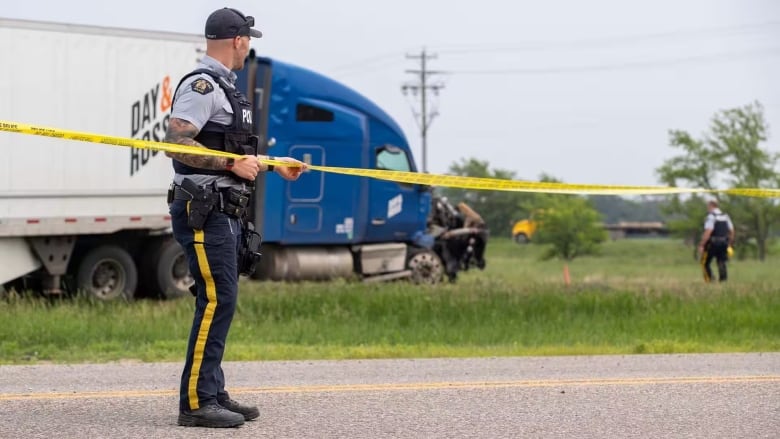U-turn option for reworking deadly Manitoba intersection 'baffling' at first, but it works: experts
'It's simplifying a driver's decision' to focus on 1 direction of traffic, U.S. engineer says

The planned redesign of a Manitoba highway intersection where 17 people were killed in a deadlycrash last year may settle on a configuration that's rare inCanada.
In order to prevent drivers from crossing a busy four-lane divided highway, one proposal offers an indirect route turn right onto the main highway, weave toward a dedicated lane for a U-turn at the median, then head in the appropriate direction.
This type of intersection has different names, but it's often called a restricted crossing U-turn, or RCUT and yes, transportation experts acknowledge it sounds confusing, but they say it works.
"It's simplifying a driver's decision," said Dan Brugman, state traffic safety engineer for theWisconsin Department of Transportation.
Right now "whenyou're coming up to that stop sign on a four-lane divided roadway, you have so much noise that you got to pay attention to, got to pay attention to four different lanes of traffic to try to shoot across in one movement," he added.
"With RCUTs, we're simplifying that driver task by having you focus on that near side flow of traffic."
WATCH | How an RCUT intersection would work:
Once it's safe to turn right, driverswould shift to the left-most lanesolelyfor U-turns andthen travel back toward the intersection to either continuewith the flow of traffic or turn right onto the other road. Drivers would only need to pay attention to one direction of traffic at a time.
No more left-turns. No more travelling through four busy lanes of traffic.
It was a bus driver's attempt tocut through four lanes of trafficthatended in tragedy on June 15, 2023,when a bus full of seniors collided with a semi-trailer truckatthe junctionof Highway 5 and the Trans-Canada Highway nearCarberry, Man.The crashkilled 17 people and injured eight others.
RCMP say the truck had the right-of-way when the bus pulled into the intersection.
The investigation into the crash is still happening, but enough has been done that RCMP have submitted a package to the Manitoba Prosecution Service for review and direction on whether any charges should be laid, an RCMP spokesperson said.
No information was provided on when the information was submitted or how long the Crown's review could take.
To improve safety, Manitoba will approve one of three options:aroundabout, a wider medianor the aforementioned RCUT, according to a commissioned report the province released on Monday.
The RCUT exists throughoutthe United States, but it'snew to Canada. Manitoba doesn't have any, and Saskatchewan just recently opened its first near Saskatoon.
U.S. transportation officials sayrestricted crossing U-turn intersections, sometimes referred to as J-turns, have successfully reduced the number of severe and fatal collisions.

In Wisconsin, those types of collisions have fallen by 70 to 80 per cent in those intersections, Brugman said.
In Minnesota, it's been around a 70 per cent reduction, said Derek Leuer,state traffic safety engineer forMinnesota's Department of Transportation.
What's even better, Leuer said, is an elimination of right-angle crashes, in which the front of one vehicle strikes the side of another. It's the type of collision most common when a driver tries to cross four-lane highways, he said.
He said Minnesota's been "gung-ho" about RCUT intersectionssince it's had the data to prove the number ofsevere crashes has plunged.
Minnesotans'thought we lost our minds'
The state now has 90-plus RCUT intersections, but Leuer admits it was tough to sell the public on the first one, built around 2010.
"They essentially thought we lost our minds," he said.
"It's just so baffling to suggest to somebody that making three manoeuvres right, U-turn, rightis somehow safer than just crossing the intersection."
Leuer said the department immediately went to work to educatethe public on the merits of the new intersection setup.
While RCUT intersectionssuccessfully reduce crash severity, the total number of collisions actually stays around the same, Leuer said. The increase is seen in minor collisions, such as a driver being struck from behind at a stop sign.

"We're going to trade these high-severity, these fatal injury crashes for property damage crashes, and I always tell people I'll take that trade all day long."
The report commissioned by the Manitoba government said an RCUT intersection near Carberry would require careful consideration because of the high volume of trucks on both highways.
That same document also expressed caution around a roundabout, which is also statistically successful, if not better, at reducing severe collisions than an RCUT.
It stateda roundabout in a high-speed rural environment as isolated as the intersection in question "can raise concern regarding driver expectation" meaning careful consideration of other speed management measures would be needed for this option.
Leuerprefers roundabouts in lower-speed environments and areas where the traffic volumes from all four directions are similar. Based on those categories, the Carberry intersection may not apply.
The Manitoba report suggests agrade-separated interchange (such as an overpass) could be introduced at that junctionin the decades to come, but current traffic volumes don't support it.
Carberry Mayor Ray Muirheadbelieves the need is already there, however.
"As recently as last Friday, we had another accident at that same intersection. Luckily nobody was hurt or killed, but it was the same thing," Muirhead said.
He also wants the median widened and speed limitsreduced as drivers are approaching.
While he, and others in the Carberry community who'd like an overpass, aren't immediately getting what they want, he said he's appreciative of what the government has presented. The provincewillconsult with community members in the months ahead.
"I'm happy that they came back with some potential solutions for that intersection, and the three options give us something to think about."
With files from CBC's Caitlyn Gowriluk














_(720p).jpg)


 OFFICIAL HD MUSIC VIDEO.jpg)
.jpg)



























































































